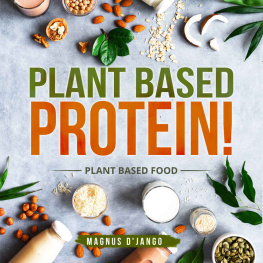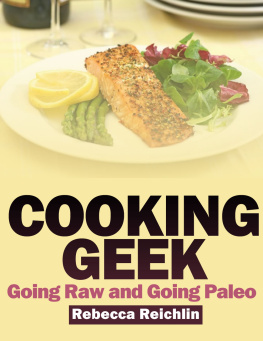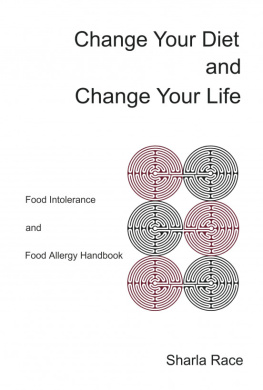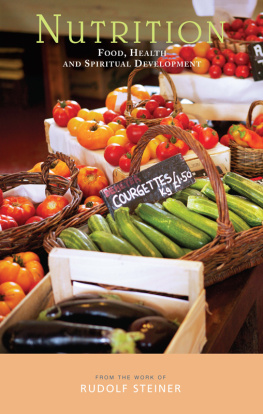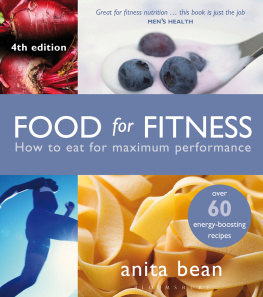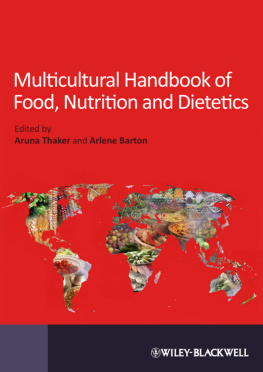THE
RAW FOOD
AN ESSENTIAL GUIDE TO
NUTRITION
UNDERSTANDING RAW FOOD DIETS
HAND BOOK
KARIN DINA, DC
WITH RICK DINA, DC

2015 Karin Dina and Rick Dina
Cover and interior design: Scattaregia Design
Healthy Living Publications
An imprint of Book Publishing Company
PO Box 99
Summertown, TN 38483
888-260-8458
bookpubco.com
ISBN: 978-1-57067-327-6
20 19 18 17 16 15 1 2 3 4 5 6 7 8 9
Library of Congress Cataloging-in-Publication Data
Dina, Karin.
The raw food nutrition handbook : an essential guide to understanding raw food diets / Karin
Dina, DC, with Rick Dina, DC.
pages cm
Includes bibliographical references and index.
ISBN 978-1-57067-327-6 (pbk.) - ISBN 978-1-57067-865-3 (e-book)
1. Raw food diet. 2. Nutrition. I. Dina, Rick. II. Title.
RM237.5.D56 2015
613.265-dc23
2015014318
Printed on recycled paper
Book Publishing Company is a member of Green Press Initiative. We chose to print this title on paper with 100% postconsumer recycled content, processed without chlorine, which saved the following natural resources:

For more information on Green Press Initiative, visit www.greenpressinitiative.org . Environmental impact estimates were made using the Environmental Defense Fund Paper Calculator. For more information visit www.papercalculator.org .
Dedication
For my dad, with all my love.
Contents
Acknowledgments

SINCERE GRATITUDE TO THE FOLLOWING PEOPLE, all of whom made this book possible:
First and foremost, Bob Holzapfel and the Book Publishing Company for giving me the opportunity to make this book a reality. My editor, Cynthia Holzapfel, for your excellent suggestions and editing. Your vision for this book was invaluable in helping me hone my message to reach a broad audience. Beth Geisler and Jim Scattaregia for your respective proofreading and design work on this book.
Cherie Soria and Dan Ladermann for giving Dr. Rick and me the opportunity to bring our Science of Raw Food Nutrition curriculum to an international audience at the Living Light Culinary Institute on the scenic northern California coast. Our students, for encouraging me to write this book and for sharing the topics that mean the most to you.
And to my amazing husband Rick Dina, DC, thank you for your endless support and enthusiasm for this and all our projects. Your writing of the protein chapter, contributions to the fat chapter, and general editing were invaluable. We make a great team.
Preface

THIS BOOK IS A HYBRID of the research-based information and my own personal and clinical experience that Ive acquired since I became interested in raw, plant-based nutrition in 1990. Ive included much of my own experience, because for all thats known about health and nutrition, theres still much that is yet to be known. On many occasions, Ive had a question for which there was not a research-based answer, and it was my clinical experience or the clinical experience of other practitioners that helped me answer the question or fill in the gaps left by research. Clinical experience doesnt provide all the answers either, so Ive found the combination of research and clinical and personal experience to be powerful for helping me achieve the health results Ive sought and have helped others find.
Peer-reviewed research that focuses specifically on raw food is most certainly a work in progress. Given that there are so many topics in the health and nutrition literature that are not well studied, I encourage people to keep an open mind about their approach to health. There are many steps and tangents in between a raw, plant-based diet and the standard Western diet. Consider where you are personally on that continuum, what results you are experiencing, and how these relate to your personal health goals. Your approach to diet doesnt necessarily have to involve extremes or what someone else considers to be ideal, and just like research, can be a work in progress.
This book doesnt require that you have a previous working knowledge of nutrition. I start with the basics and build on this foundation as the book progresses. In order to clarify areas of confusion that people may experience, I touch on topics that are often misreported in the media or misunderstood. These include glycemic index and load, vitamins B12 and D, and oxalates in leafy greens, to name a few. Throughout the book, I make distinctions among research-based information, clinically derived information, anecdotal or personal experience, and my own opinion. I think that its important for people to know the source of my information and that I find information from all these sources to be very interesting and relevant.
Consider the following before you begin:
There is much useful information in this book, but its just the beginning, representing a portion of what Ive learned over the years. In a sense this book is a clearinghouse for the raw food nutrition topics I find most important for success, as well as those that are most misunderstood. Expanded information on these topics, as well as many additional relevant topics not covered here, are included in our series of Science of Raw Food Nutrition classes.
The information in this book is not medical, health, or dietary advice and should not be treated as such. The menu plans in this book are examples of foods and diet structures that I have observed in the raw community. Any type of dietary change or nutritional therapy should always be undertaken with the supervision of a qualified health care practitioner.
The nutrient content of foods in this book was compiled from the US Department of Agriculture (USDA) National Nutrient Database for Standard Reference and ESHA Food Processor, both of which provide the nutrient content of nonorganically grown foods, unless specified. I look forward to a time when the content of specific nutrients is measured in organic foods and reported in nutrition databases for comparison to nonorganic foods.
The foods analyzed for nutrient content are raw unless otherwise specified. To the best of my ability, Ive omitted hard-to-find and expensive foods in order to give readers the most cost-effective choices possible. I would encourage those of you who live in areas where tropical foods are abundant and inexpensive to evaluate the nutrient content of these foods and suitability for inclusion in your diet.
The amounts of foods analyzed in this book are servings that are common for many raw-food enthusiasts. As will be discussed in this book, when someone starts replacing heavier cooked foods with raw fruits and vegetables, they generally eat a greater volume overall than they did previously, because fruits and vegetables have lower calorie density than heavier cooked foods (see ). If the serving sizes are too large for you, feel free to adjust them. If you divide a serving in half, simply divide the nutrient content in half to obtain the values for the new serving.



